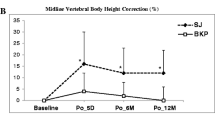Abstract
Background
There is controversy about how to treat vertebral fractures. Conservative care is the default approach. Radiofrequency kyphoplasty uses ultrahigh viscosity cement to restore spinal posture and stabilize the fracture. The aims of this study were to compare radiofrequency kyphoplasty to conservative care and assess the usual algorithm of starting all patients on conservative care for 6 weeks before offering surgery.
Methods
Elderly patients with painful osteoporotic vertebral compression fractures were all treated with 6 weeks of conservative care (analgesics, bracing, and physiotherapy). They were then offered the choice of continuing conservative care or crossing over to radiofrequency kyphoplasty, at 6 and 12 weeks. Clinical success was defined as: (1) VAS pain improvement ≥2, (2) final VAS pain ≤5, (3) no functional worsening on ODI.
Results
After the initial 6 weeks of conservative care, only 1 of 65 patients met the criteria for clinical success, and median VAS improvement was 0. After 12 weeks of conservative care, only 5 of 38 patients met the criteria for clinical success, and median VAS improvement was 1. At the 6-week follow-up after radiofrequency kyphoplasty, 31 of 33 surgery patients met the criteria for clinical success, and median VAS improvement was 5.
Conclusion
For the vast majority of patients with a VAS ≥5, conservative care did not provide meaningful clinical improvement. In contrast, nearly all patients who underwent radiofrequency kyphoplasty had rapid substantial improvement. Surgery was clearly much more effective than conservative care and should be offered to patients much sooner.




Similar content being viewed by others
References
Buchbinder R, Osborne RH, Ebeling PR, Wark JD, Mitchell P, Wriedt C, Graves S, Staples MP, Murphy B (2009) A randomized trial of vertebroplasty for painful osteoporotic vertebral fractures. NEJM 361:557–568
Kalmes DF, Comstock BA, Heagerty PJ et al (2009) A randomized trial of vertebroplasty for osteoporotic spinal fractures. NEJM 361:569–579
Weinstein JN (2009) Balancing science and informed choice in decisions about vertebroplasty. NEJM 361:619–621
Aebi M (2009) Vertebroplasty: about sense and nonsense of uncontrolled “controlled randomized prospective trials”. Eur Spine J 18:1247–1248
Noonan P (2009) Randomized vertebroplasty trials: bad news or sham news? Am J Neuroradiol 30:1808–1809
Kalmes D, Buchbinder R, Jarvik J, Heagerty P, Comstock B, Turner J, Osborne R (2009) Response to “randomized vertebroplasty trials: bad news or sham news?”. Am J Neuroradiol 30:1809–1810
Buchbinder R, Osborne RH, Kallmes D (2009) Vertebroplasty appears no better than placebo for painful osteoporotic spinal fractures, and has potential to cause harm. MJA 191:476–477
Clark WA, Diamond TH, McNeil HP, Gonski PN, Schlaphoff GP, Rouse JC (2010) Vertebroplasty for painful acute osteoporotic vertebral fractures: recent Medical Journal of Australia editorial is not relevant to the patient group that we treat with vertebroplasty. MJA 192:334–337
Buchbinder R, Osborne RH, Kallmes D (2010) Invited editorial presents an accurate summary of the results of two randomized placebo-controlled trials of vertebroplasty. MJA 192:338–341
Van Der Weyden MB (2010) Vertebroplasty, evidence and professional protest. MJA 192:301–302
Sox HC, Greenfield S (2009) Comparative effectiveness research: a report from the Institute of Medicine. Ann Intern Med 151:203–205
Luce BR, Kramer JM, Goodman SN, Connor JT, Tunis S, Whicher D, Schwartz JS (2009) Rethinking randomized clinical trials for comparative effectiveness research: the need for transformational change. Ann Intern Med 151:206–209
Schneeweiss S (2009) On guidelines for comparative effectiveness research using nonrandomized studies in secondary data sources. Value Health 12:1041
American Academy of Orthopedic Surgeons. The Treatment of Symptomatic Osteoporotic Spinal Compression Fractures: Guideline and Evidence Report. Accessed on 16 December 2010 at: http://www.aaos.org/Research/guidelines/SCFguideline.pdf
Elgeti FA, Marnitz T, Kröncke TJ, Gebauer B (2010) DFine Radiofrequenzkyphoplastie (RFK)—Kyphoplastie mit ultrahochviskösem Zement. RöFo 182:803–805
Bae HW, Linovitz R, Maurer P et al (2010) Correlation of early pain and long-term functional results from a multi-center, prospective, randomized, controlled FDA-IDE vertebroplasty trial. Spine J 10:64S–65S
Klazen CAH, Lohle PNM, de Vries J et al (2010) Vertebroplasty versus conservative treatment in acute osteoporotic vertebral compression fractures (Vertos II): an open-label randomised trial. Lancet 376:1031–1033
Wardlaw D, Cummings SR, Van Meirhaeghe J, Bastian L, Tillman JB, Ranstam J, Eastell R, Shabe P, Talmadge K, Boonen S (2009) Efficacy and safety of balloon kyphoplasty compared with non-surgical care for vertebral compression fracture (FREE): a randomised controlled trial. Lancet 373:1016–1024
Acknowledgments
We would like to thank Ayçe Atalay, MD, and Adela Castelló MPH, MSc, (both from Mercury Medical Research & Writing) for contributing to database quality control (AA) and statistical analysis (AA and AC).
Conflict of interest
None.
Author information
Authors and Affiliations
Corresponding author
Rights and permissions
About this article
Cite this article
Bornemann, R., Hanna, M., Kabir, K. et al. Continuing conservative care versus crossover to radiofrequency kyphoplasty: a comparative effectiveness study on the treatment of vertebral body fractures. Eur Spine J 21, 930–936 (2012). https://doi.org/10.1007/s00586-012-2148-8
Received:
Revised:
Accepted:
Published:
Issue Date:
DOI: https://doi.org/10.1007/s00586-012-2148-8




